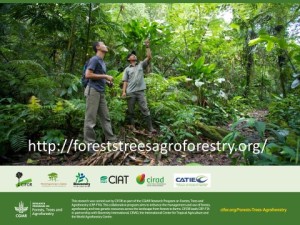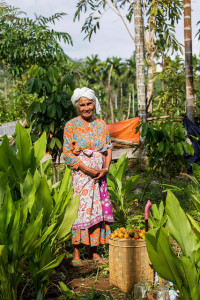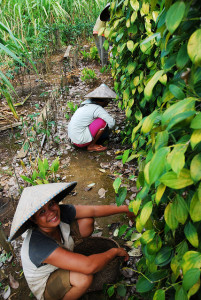By Rob Finlayson, originally published at Agroforestry World Blog
 Understanding the roles trees play in landscapes is a critical task undertaken by a global research partnership. At the Asia-Pacific Forestry Week 2016, scientists called for more partners to join them so that knowledge can be shared more effectively.
Understanding the roles trees play in landscapes is a critical task undertaken by a global research partnership. At the Asia-Pacific Forestry Week 2016, scientists called for more partners to join them so that knowledge can be shared more effectively.
Since 2011, the CGIAR Research Program on Forests, Trees and Agroforestry has been marshalling a global, multidisciplinary team of hundreds of researchers to better understand forests and the trees beyond them, in particular, agroforests: trees planted and/or managed by farmers.
While woody perennials feature prominently in the title of the program, the human side of the equation is what occupies much research interest, especially given the increasing world population with a concomitant increasing demand for food and competition over land.
More partners are being called on to join with the Program’s researchers to increase the scope of research and maximize the spread of its knowledge to governments, businesses and farmers.
The Program is led by the Center for International Forestry Research (CIFOR) in collaboration with the World Agroforestry Centre (ICRAF), Bioversity International, Centro Internacional de Agricultura Tropicale (International Centre for Tropical Agriculture), Centre de Coopération Internationale en Recherche Agronomique pour le Développement (French Agricultural Research Centre for International Development), and Centro Agronómico Tropical de Investigación y Enseñanza (Tropical Agricultural Research and Higher Education Center).
A host of national research institutions, farmers’ associations, government agencies of all sizes and jurisdictions, large and small businesses and farmers work with the Program’s main partners on a range of projects in some 35 countries (the number varies).

Since its inception, the program’s researchers have been focusing on critical issues affecting the planet to do with trees and poor farmers’ livelihoods in the developing world, such as reducing emissions from deforestation and forest degradation plus conservation (REDD+), agroforestry systems for tropical and dryland areas, reform of forest tenure regimes, forest fires in Indonesia and “climate-smart” agriculture.
“Scientists of the CGIAR Research Program on Forests, Trees and Agroforestry are the source of much of the research findings being discussed here at Asia-Pacific Forestry Week,” said Meine van Noordwijk, one of the CGIAR FTA’s coordinators.
He was referring to the regional bi-annual conference co-hosted by the Food and Agriculture Organization of the United Nations and the Philippine Department of Environment and Natural Resources, which was held in February 2016 at Clark, the Philippines.
He was speaking at a special session, held to encourage other organizations to join the research program.
“The second phase of the program starts next year,” he said, “so we are calling on other organisations to join with us not only to better share the knowledge we have already accrued but also work together to more effectively research emerging critical areas.”
The world is at a turning point, van Noordwijk added, and the work of the program is already having impacts on the decisions made by politicians, bureaucracies, businesses and farmers in the face of climate change, increasing demand for food and the need to protect and maintain the services provided by ecosystems.
“The world has made huge progress on development but at a huge cost to environmental integrity,” he emphasized. “We can continue and it will crash or we can move towards a sustainable future.”

To more quickly understand how we can reach that future through better use of trees, the program has bundled activities around common topics and functions organized by scale, such as livelihoods, landscapes, trade, governance, climate change, biodiversity, gender, capacity development, communications and partnerships.
“Fundamental questions remain to be answered,” said co-presenter Christopher Martius, “such as what influences people to transform their behaviour instead of carrying on business as usual.”
One large experiment conducted by FTA researchers is examining this question, among many others: the Sentinel Landscapes Network comprises seven landscapes that straddle 13 countries from Africa to Asia, involving 280 villages, 8500 households and 4480 points for verification of research on the ground.
“It seems most likely that a multi-layered system of knowledge creation and sharing is needed,” said van Noordwijk, who is chief science advisor at the World Agroforestry Centre. A system where people in the field can more easily get hold of the knowledge they need to effectively manage their farms or forests or whole landscapes and where researchers and governments can more easily learn from local knowledge about natural and human systems.
‘This has prompted our call to other national and international organizations to join us to share knowledge. If research can become even more participatory and local while still linking to the national and international levels then there will be a much greater chance of us all—and the planet— creating the sustainable future we want through the effective management of trees in landscapes. Please join us in making this happen’.
For more information contact
Meine van Noordwijk: m.vannoordwijk@cgiar.org
Christopher Martius: c.martius@cgiar.org











